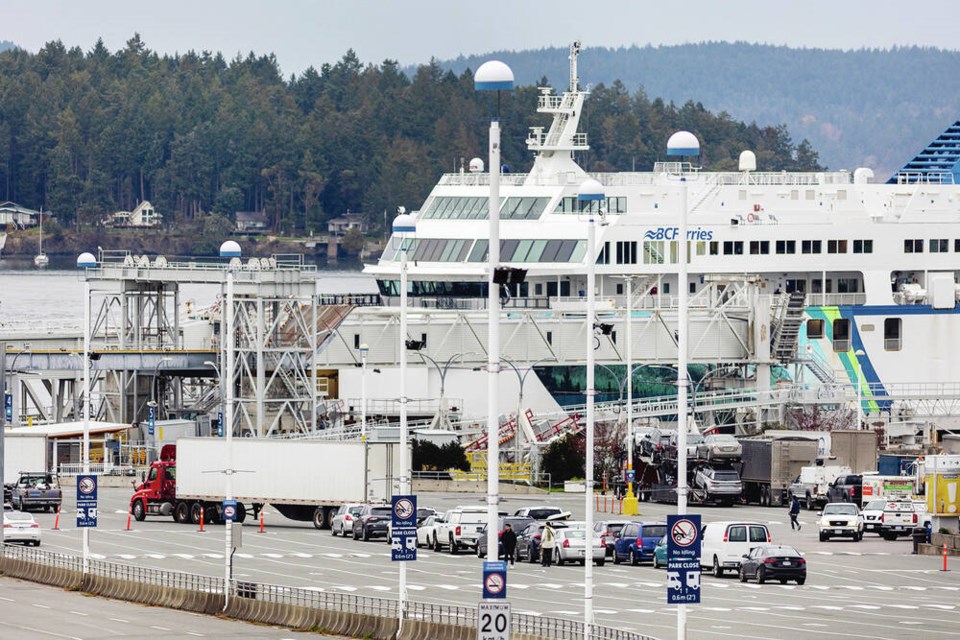sa���ʴ�ý Ferries has issued a call for shipyards interested in designing and building seven large diesel-battery hybrid ferries in what will be a milestone investment in ships by the corporation.
The first vessel in the new ferry class is expected to be ready for service in 2029, sa���ʴ�ý Ferries spokesperson Deborah Marshall said Tuesday.
The vessels will operate between Vancouver Island and the Lower Mainland and between the Sunshine Coast and the mainland.
They would replace six major ferries retiring between 2029 and 2032: Queen of Coquitlam, Queen of Alberni, Queen of Cowichan, Queen of New Westminster, Queen of Surrey and Queen of Oak Bay.
Marshall said the new vessels will “provide an enhanced customer experience, improved reliability and reduced environmental impact.”
sa���ʴ�ý Ferries is encouraging sa���ʴ�ý shipyards to review the request for expressions of interest, which is open to local, national and international bidders, Marshall said.
The opportunity, issued through shipbroker H. Clarkson and Co. Ltd., headquartered in London, England, closes Dec. 1.
It will be followed by a request for supplier qualifications early in 2024 to qualify shipyards for the subsequent request for proposals expected in June of next year.
The project is expected to go to sa���ʴ�ý Ferries’ board of directors for approval next summer, Marshall said.
If the board endorses the plan, an application will go to the sa���ʴ�ý Ferries Commissioner for approval.
The contract for the new diesel-battery hybrid is to be awarded in December 2024. The type of diesel fuel was not specified.
Each new ferry will be able to carry 2,100 passengers and crew, similar to the Spirit-class ferries.
Plans call for three passenger decks and two vehicle decks. The vessels would be less than 564 feet and have a maximum displacement of 11,800 tonnes fully loaded.
No cost estimates are being revealed so as not to compromise the competitive bidding process, Marshall said.
The project has been stalled a couple of times, most recently by the pandemic, when sa���ʴ�ý Ferries instead chose to carry out five-year life extensions on major vessels.
In 2018, when sa���ʴ�ý Ferries issued a request for interest to build five major vessels, a senior official estimated the project could cost $700 million to $1 billion.
Fleet renewal is part of sa���ʴ�ý Ferries’ $5.2-billion capital plan running to fiscal year 2034. It anticipates adding more Island-class vessels and rebuilding its fleet maintenance yard in Richmond.
Major ferry contracts have been going offshore for several years. The three Coastal-class ferries were built in 2007 and 2008 in Germany, while Salish-class ferries were built in Poland by Remontowa Shipbuilding S.A. and Island-class ferries were constructed by Netherlands-based Damen Shipyards in Romania.
Chuck Ko, president of Allied Shipbuilders in North Vancouver, anticipates an offshore company will be the successful applicant, but said he would welcome the chance to be a partner in a smaller portion of the work.
North Vancouver-based Seaspan, which is building non-combat ships under the National Shipbuilding Strategy, has heavily invested in its shipyard and drydock, and is expressing interest in the major vessels program.
Ali Hounsell, director of communications at Seaspan, said the company is interested in "playing a significant role" in sa���ʴ�ý Ferries’ new major vessels program.
With Victoria Shipyards and its Vancouver operations, Seaspan is one of the largest providers of maintenance and repair for sa���ʴ�ý Ferries, particularly for their large vessel fleet, he said.
Under the Canadian National Shipbuilding Strategy, Seaspan has rebuilt the large-vessel shipbuilding industry in sa���ʴ�ý, Hounsell said.
"Seaspan has one of the most modern shipyards in North America, a skilled trades workforce building new ships, and an engineering and design team numbering over 300. The company has developed a supply chain with more than 700 companies in sa���ʴ�ý, of which over 500 are in sa���ʴ�ý”
To date Seaspan has delivered three large vessels to the Canadian Coast Guard and is currently building two large joint support ships for the Royal Canadian Navy. The joint support vessels are larger and more complex than sa���ʴ�ý Ferries’ new major vessels, it says.
Shawn Sly, business agent and financial secretary for Local 506 of the Marine and Shipbuilders Union, hopes Seaspan will bid. “It would be good for future work for our members.”
Training facilities to bolster shipyard trades have been developed at colleges in sa���ʴ�ý in the wake of the national shipbuilding strategy, he noted.
Once Seaspan wraps up some of its major national projects, Sly is hoping that sa���ʴ�ý Ferries work would be available.
A spokesperson for Davie shipyard of Levis, Quebec said it had no comment. That company announced early this month that it had bought the assets of Helsinki Shipyard Oy in Finland. That yard’s output includes ferries and cruise ships.
>>> To comment on this article, write a letter to the editor: [email protected]



